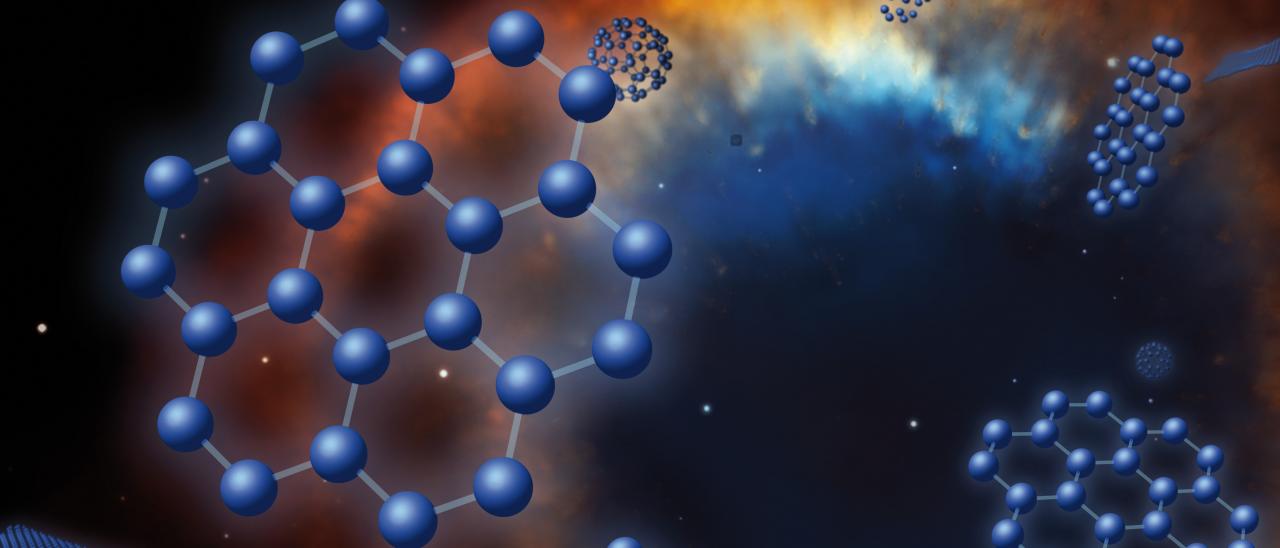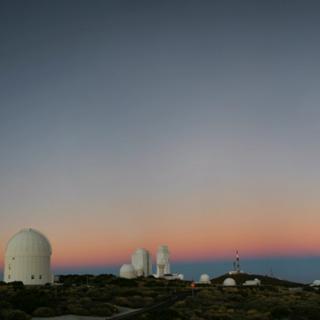Subvenciones relacionadas:
General
Las estrellas de masa baja e intermedia (M < 8 masas solares, Ms) representan la mayoría de estrellas en el Cosmos y terminan sus vidas en la Rama Asintótica de las Gigantes (AGB) - justo antes de formar Nebulosas Planetarias (NPs) - cuando experimentan procesos nucleosintéticos y moleculares complejos. Las estrellas AGB son importantes contribuyentes al enriquecimiento del medio interestelar, donde nacen nuevas estrellas y planetas (incluyendo nuestro propio Sistema Solar Temprano, SST) y a la evolución química de sistemas estelares como cúmulos globulares (CGs) y galaxias. En particular, las AGBs más masivas (M > 4-5 Ms) sintetizan (radio)isótopos muy diferentes de los formados por AGBs menos masivas y explosiones de Supernova debido a los diferentes mecanismos de nucleosíntesis. Las estrellas evolucionadas en la fase de transición entre AGBs y NPs también forman diversos compuestos orgánicos como PAHs y nanoestructuras moleculares de fullereno y grafeno, siendo un maravilloso laboratorio Astroquímico. Colaboraciones astronómicas punteras como SDSS-IV/APOGEE-2 y el próximo telescopio espacial James Webb representan un paso fundamental para entender la nucleosíntesis y los procesos moleculares en estrellas evolucionadas. Se pretende explorar la nucleosíntesis de (radio)isótopos ligeros/pesados en estrellas AGB y como éstas contribuyen a la radioactividad del SST así como a la formación/evolución de CGs y galaxias. También se pretende entender el proceso de formación "top-down" de nanoestructuras moleculares de fullereno y grafeno en estrellas evolucionadas. Finalmente, se pretende realizar minería de datos obtenidos con el satélite Gaia, para estudiar la fase evolutiva AGB-NP, y además utilizar el telescopio espacial GALEX para descubrir estrellas binarias en NPs Galácticas.
Miembros
Resultados
1. Durante 2020, se han publicado 37 artículos en revistas astronómicas internacionales con referee de alto impacto (incluyendo un review invitado), así como 2 artículos en la revista de Química-Física FNCN.
2. Se han descubierto, por primera vez, estrellas muy ricas en fósforo y cuyo patrón químico no es predicho por ninguna teoría actual de nucleosíntesis estelar.
3. Se ha demostrado que las estrellas ricas en fósforo representan un nuevo sitio estelar para la formación de elementos muy pesados, con importantes implicaciones para la evolución química de nuestra Galaxia.
Actividad científica
Publicaciones relacionadas
-
EPOXI: Comet 103P/Hartley 2 Observations from a Worldwide CampaignEarth- and space-based observations provide synergistic information for space mission encounters by providing data over longer timescales, at different wavelengths and using techniques that are impossible with an in situ flyby. We report here such observations in support of the EPOXI spacecraft flyby of comet 103P/Hartley 2. The nucleus is smallMeech, K. J. et al.
Fecha de publicación:
62011 -
UV photolysis of polyynes at λ=254 nm and at λ>222 nmNot AvailableCataldo, Franco et al.
Fecha de publicación:
62008 -
The Chemical Composition of Cernis 52 (BD+31° 640)We present an abundance analysis of the star Cernis 52 in whose spectrum we recently reported the naphthalene cation in absorption at 6707.4 Å. This star is on a line of sight to the Perseus molecular complex. The analysis of high-resolution spectra using a χ2-minimization procedure and a grid of synthetic spectra provides the stellar parametersGonzález Hernández, J. I. et al.
Fecha de publicación:
112009 -
Stability of C60 and C70 fullerenes toward corpuscular and γ radiationThe stability of C60 and C70 fullerenes in the interstellar medium deposited on dust surface or embedded in meteorites and comets has been simulated with γ irradiation and with He+ ion bombardment. It is shown by vibrational spectroscopy that a γ radiation dose of 2.6MGy (1Gy = 1 joule absorbed energy per kilogram) causes partial oligomerization ofCataldo, Franco et al.
Fecha de publicación:
42009 -
Solid state radiolysis of amino acids in an astrochemical perspectiveThe aliphatic amino acids L-alanine and L-leucine and the aromatic amino acids L-phenylalanine, L-tyrosine and L-tryptophan were irradiated in the solid state to a dose of 3.2 MGy. The degree of decomposition was measured by differential scanning calorimetry (DSC). Furthermore the degree of radioracemization was measured by optical rotatoryCataldo, Franco et al.
Fecha de publicación:
12011 -
On the action of UV photons on hydrogenated fulleranes C60H36 and C60D36Fulleranes, the hydrogenated fullerenes C60H36 and C60D36 have been synthesized in n-hexane where they show an absorption maximum at 217 nm in their electronic absorption spectra with molar extinction coefficients ɛ217 = 17140 and 16480L cm-1 mol-1, respectively, which correspond to absorption cross-sections of order 6500 Mbarn, about 10 timesCataldo, Franco et al.
Fecha de publicación:
112009 -
Infrared spectroscopy of hydrogenated fullerenes (fulleranes) at extreme temperaturesThe infrared spectra, as well as the integrated molar absorptivity (Ψ) and the molar extinction coefficient (ɛ) of each infrared transition of the hydrogenated fullerenes (known as fulleranes) C60H36, C60H18 and C70H38, and a mixture of fulleranes generally referred to as 77 per cent of C60Hx and 22 per cent C70Hy with x≈y > 30, are presented andIglesias-Groth, S. et al.
Fecha de publicación:
72012 -
Infrared spectroscopy and integrated molar absorptivity of C60 and C70 fullerenes at extreme temperaturesThe detection of C60 and C70 fullerenes in young planetary nebulae and in reflection nebulae suggests that these molecules are more common in certain astrophysical environments than previously thought. The dependence on temperature of the positions and widths of the infrared bands of the C60 and C70 fullerenes is needed for a firm qualitativeIglesias-Groth, S. et al.
Fecha de publicación:
52011 -
Evidence for the Naphthalene Cation in a Region of the Interstellar Medium with Anomalous Microwave EmissionWe report high-resolution spectroscopy of the moderately reddened (AV=3) early-type star Cernis 52 located in a region of the Perseus molecular cloud complex with anomalous microwave emission. In addition to the presence of the most common diffuse interstellar bands (DIBs) we detect two new interstellar or circumstellar bands coincident to within 0Iglesias-Groth, S. et al.
Fecha de publicación:
92008 -
Amino acids in comets and meteorites: stability under gamma radiation and preservation of the enantiomeric excessAmino acids in Solar system bodies may have played a key role in the chemistry that led to the origin of life on Earth. We present laboratory studies testing the stability of amino acids against high energy radiation. All the 20 chiral amino acids in the levo form found in the proteins of the current terrestrial biochemistry were irradiated in theIglesias-Groth, S. et al.
Fecha de publicación:
12011 -
A search for naphthalene in diffuse interstellar cloudsWe have obtained high-resolution optical spectroscopy of 10 reddened O-type stars with Ultraviolet and Visual Echelle Spectrograph at Very Large Telescope to search for interstellar bands of the naphthalene cation (C10H8+) in the intervening clouds. No absorption features were detected near the laboratory strongest band of this cation at 6707 ÅIglesias-Groth, S. et al.
Fecha de publicación:
32012 -
A search for interstellar anthracene towards the Perseus anomalous microwave emission regionWe report the discovery of a new broad interstellar (or circumstellar) band at 7088.8 +/- 2.0 Å coincident to within the measurement uncertainties with the strongest band of the anthracene cation (C14H10+) as measured in gas-phase laboratory spectroscopy at low temperatures. The band is detected in the line of sight of star Cernis 52, a likelyIglesias-Groth, S. et al.
Fecha de publicación:
102010 -
A photometric redshift of z = 1.8{+0.4}{-0.3} for the AGILE GRB 080514BThe AGILE gamma-ray burst GRB 080514B is the first detected to have emission above 30 MeV and an optical afterglow. However, no spectroscopic redshift for this burst is known. We report on our ground-based optical/NIR and millimeter follow-up observations of this event at several observatories, including the multi-channel imager GROND on La SillaRossi, A. et al.
Fecha de publicación:
112008 -
The Formation of Fullerenes: Clues from New C60, C70, and (Possible) Planar C24 Detections in Magellanic Cloud Planetary NebulaeWe present 10 new Spitzer detections of fullerenes in Magellanic Cloud Planetary Nebulae, including the first extragalactic detections of the C70 molecule. These new fullerene detections together with the most recent laboratory data permit us to report an accurate determination of the C60 and C70 abundances in space. Also, we report evidence forGarcía-Hernández, D. A. et al.
Fecha de publicación:
82011



